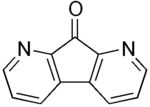 | |
| Names | |
|---|---|
| IUPAC name 9H-pyrido[3',2':3,4]cyclopenta[1,2-b]pyridin-9-one | |
| Other names DFO 9H-1,8-Diazafluoren-9-one 9H-Cyclopenta[1,2-b:4,3-b']dipyridin-9-one | |
| Identifiers | |
3D model (JSmol) | |
| ChemSpider | |
PubChem CID | |
CompTox Dashboard (EPA) | |
| |
SMILES
| |
| Properties | |
| C11H6N2O | |
| Molar mass | 182.18 g/mol |
| Melting point | 229 to 233 °C (444 to 451 °F; 502 to 506 K) |
Except where otherwise noted, data are given for materials in their standard state (at 25 °C [77 °F], 100 kPa). | |
1,8-Diazafluoren-9-one, also known as DFO, is a chemical that is used to find fingerprints on porous surfaces. It makes fingerprints glow when they are lit by blue-green light.
DFO reacts with amino acids present in the fingerprint to form highly fluorescent derivatives. Excitation with light at ~470 nm results in emission at ~570 nm.[1]
References
- ^ Pounds, C. Anthony; Grigg, Ronald; Mongkolaussavaratana, Theeravat (1 January 1990). "The Use of 1,8-Diazafluoren-9-one (DFO) for the Fluorescent Detection of Latent Fingerprints on Paper. A Preliminary Evaluation". Journal of Forensic Sciences. 35 (1): 169–175. doi:10.1520/JFS12813J.
External links